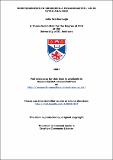Files in this item
Morphogenesis in Drosophila melanogaster : an in vitro analysis
Item metadata
| dc.contributor.advisor | Milner, Martin | |
| dc.contributor.author | Scarborough, Julie | |
| dc.coverage.spatial | 327 | en |
| dc.date.accessioned | 2007-05-31T08:50:27Z | |
| dc.date.available | 2007-05-31T08:50:27Z | |
| dc.date.issued | 2007-07 | |
| dc.identifier | uk.bl.ethos.552000 | |
| dc.identifier.uri | https://hdl.handle.net/10023/337 | |
| dc.description.abstract | The aim of this thesis was to investigate morphogenesis in the fruit fly Drosophila melanogaster using three in vitro tissue culture systems. Primary embryonic cultures derived from Drosophila melanogaster were used to study the effect of the moulting hormone ecdysone on cells in culture. The hypothesis was that the effect of ecdysone on these primary embryonic cells would parallel events which occur during metamorphosis in vivo and therefore the primary embryonic cultures could be used as an ‘in vitro’ model system. Transgenic fly lines expressing GFP were used to visualise and identify specific cell types and it was shown that cells in primary embryonic cultures respond to ecdysone morphologically. However due to the variability of cultures it was concluded that this culture system was not suitable for use as a model system. As defined cell types were observed the development of a protocol suitable for use with the primary embryonic culture system using dsRNA in order to demonstrate RNA interference was undertaken. Although this was unsuccessful, as cells in the primary embryonic cultures appeared to be resistant to dsRNA, some technical avenues remain to be explored. The Drosophila melanogaster cell line, Clone 8+, was used to investigate cell adhesion in tissue culture. Statistical analyses were carried out and it was established that derivatives of the parent cell line, Clone 8+, showed differential adhesion and proliferation characteristics. Analysis of microarray data was carried out in order to identify genes which may be responsible for the loss of cell adhesion in Clone 8+ cell lines and the potential roles of these genes in adhesion were discussed. A gene of interest, glutactin, was identified which may be responsible for loss of cell adhesion. Antibody staining was used to establish the expression of the protein glutactin in the Clone 8+ cell lines. The expression of glutactin suggested that the Clone 8+ cell line had maintained properties of the wing disc epithelial cell-type and disruption of cell polarity was considered as a possible mechanism. It was shown that f-actin colocalised with glutactin and the role of the cytoskeleton in glutactin secretion was discussed. It was concluded that glutactin was not responsible for loss of cell adhesion in the Clone 8+ cell lines. Further analysis of the microarray data revealed potential genes that could be responsible for the loss of cell polarity in the Clone 8+ cell lines and the possibility of cellular senescence was considered. It was hypothesised that the properties of adhesion and proliferation related to their ‘in vitro’ age. In the final investigation the movement of epithelial cells in Drosophila melanogaster third instar larval imaginal discs during morphogenesis was investigated. Firstly a lumen was identified in fixed imaginal disc tissue in association with cells expressing f-actin. This result was discussed in relation to the process of dorsal closure and wound healing. Further investigations involved live imaging of the dynamic process of evagination in the imaginal wing disc using transgenic flies expressing moesin-GFP. It was concluded that the lumen was not associated with the process of wound healing and it was concluded that the lumen appeared to be the mechanism directing peripodial epithelium contraction during morphogenesis of the imaginal wing disc. Dorsal closure and the process of invagination in relation to morphogenesis of the imaginal wing disc were discussed. | en |
| dc.format.extent | 10323306 bytes | |
| dc.format.mimetype | application/pdf | |
| dc.language.iso | en | en |
| dc.publisher | University of St Andrews | |
| dc.rights | Creative Commons Attribution-NonCommercial-NoDerivs 3.0 Unported | |
| dc.rights.uri | http://creativecommons.org/licenses/by-nc-nd/3.0/ | |
| dc.subject | Drosophila | en |
| dc.subject | Primary cultures and RNAi | en |
| dc.subject | Cell adhesion | en |
| dc.subject | Microarray analysis | en |
| dc.subject | Glutactin | en |
| dc.subject | Aging and cell senescence | en |
| dc.subject | Peripodial epithelium | en |
| dc.subject | Lumen | en |
| dc.subject | Woundhealing | en |
| dc.subject | Dorsal closure | en |
| dc.subject | Invagination | en |
| dc.subject.lcc | QL537.D76S3 | |
| dc.subject.lcsh | Drosophila melanogaster | en |
| dc.subject.lcsh | Morphogenesis | en |
| dc.title | Morphogenesis in Drosophila melanogaster : an in vitro analysis | en |
| dc.type | Thesis | en |
| dc.contributor.sponsor | Biotechnology and Biological Sciences Research Council (BBSRC) | en |
| dc.type.qualificationlevel | Doctoral | en |
| dc.type.qualificationname | PhD Doctor of Philosophy | en |
| dc.publisher.institution | The University of St Andrews | en |
This item appears in the following Collection(s)
Except where otherwise noted within the work, this item's licence for re-use is described as Creative Commons Attribution-NonCommercial-NoDerivs 3.0 Unported
Items in the St Andrews Research Repository are protected by copyright, with all rights reserved, unless otherwise indicated.


